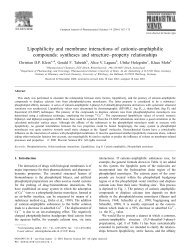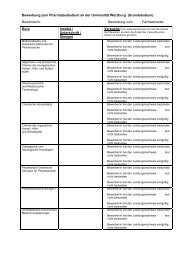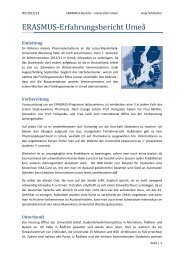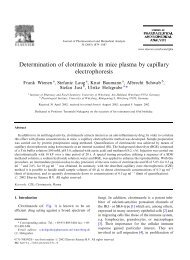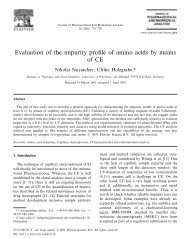1H and 13C nuclear magnetic resonance studies of the sites of ...
1H and 13C nuclear magnetic resonance studies of the sites of ...
1H and 13C nuclear magnetic resonance studies of the sites of ...
Create successful ePaper yourself
Turn your PDF publications into a flip-book with our unique Google optimized e-Paper software.
Journal <strong>of</strong> Pharmaceutical <strong>and</strong> Biomedical Analysis<br />
20 (1999) 297–307<br />
1<br />
H <strong>and</strong> 13 C <strong>nuclear</strong> <strong>magnetic</strong> <strong>resonance</strong> <strong>studies</strong> <strong>of</strong> <strong>the</strong> <strong>sites</strong><br />
<strong>of</strong> protonation in itraconazole <strong>and</strong> fluconazole<br />
E. Inkmann, U. Holzgrabe *<br />
Pharmaceutical Institute, Uniersity <strong>of</strong> Würzburg, Am Hubl<strong>and</strong>, D-97074 Würzburg, Germany<br />
Received 27 July 1998; received in revised form 4 November 1998; accepted 14 November 1998<br />
Abstract<br />
1<br />
H <strong>and</strong> 13 C <strong>nuclear</strong> <strong>magnetic</strong> <strong>resonance</strong> spectra <strong>of</strong> itraconazole were measured in neutral solution, <strong>and</strong> upon<br />
addition <strong>of</strong> varying amounts <strong>of</strong> deuterated hydrochloride acid. The comparison <strong>of</strong> <strong>the</strong> chemical shift in <strong>the</strong> different<br />
solutions revealed <strong>the</strong> high proton affinity <strong>of</strong> <strong>the</strong> piperazine nitrogen N26. Upon addition <strong>of</strong> a surplus <strong>of</strong> acid, <strong>the</strong><br />
triazole ring was protonated. Corresponding observations were made for fluconazole. © 1999 Elsevier Science B.V.<br />
All rights reserved.<br />
Keywords: Itraconazole; Sites <strong>of</strong> protonation; Nuclear <strong>magnetic</strong> <strong>resonance</strong><br />
1. Introduction<br />
Itraconazole (()-2-sec-butyl-4-[4-(4-{4[(2R*,<br />
4S*)-2-(2,4-dichlorophenyl)-2-(<strong>1H</strong>-1,2,4-triazol-1-<br />
ylmethyl)-1,3-dioxolan-4-ylmethoxy]phenyl} piperazin-1-yl)phenyl]-2,4-dihydro-1,2,4-triazol-3-one)<br />
is an orally active, azole-type antifungal agent,<br />
which can be used for <strong>the</strong> treatment <strong>of</strong> oropharyngeal<br />
<strong>and</strong> vulvovaginal c<strong>and</strong>idiasis, as well as <strong>of</strong><br />
dermatophytoses [1]. All azoles exert <strong>the</strong>ir activity<br />
* Corresponding author. Tel.: +49-931-315460.<br />
E-mail address: holzgrabe@pharmazie.uni-wuerzburg.de (U.<br />
Holzgrabe)<br />
through <strong>the</strong> specific inhibition <strong>of</strong> cytochrom P-<br />
450. Since <strong>the</strong> N-3 atom <strong>of</strong> <strong>the</strong> azole moiety (see<br />
Scheme 1) is believed to bind to <strong>the</strong> ferric ion in<br />
<strong>the</strong> heme pros<strong>the</strong>tic group <strong>and</strong> <strong>the</strong> N-1 substituents<br />
are able to enhance <strong>the</strong> affinity [2], it is<br />
important to know whe<strong>the</strong>r one <strong>of</strong> <strong>the</strong> nitrogens<br />
will be protonated under physiological conditions<br />
or in <strong>the</strong> presence <strong>of</strong> <strong>the</strong> target protein. Thus, it<br />
was <strong>the</strong> purpose <strong>of</strong> this study to find out <strong>the</strong> site<br />
<strong>of</strong> protonation by means <strong>of</strong> 1 H <strong>and</strong> 13 C <strong>nuclear</strong><br />
<strong>magnetic</strong> <strong>resonance</strong> (NMR) measurements using<br />
varying amounts <strong>of</strong> acid. For sake <strong>of</strong> comparison,<br />
NMR data <strong>of</strong> fluconazole <strong>and</strong> ketoconazole (see<br />
Scheme 1) were taken into account.<br />
0731-7085/99/$ - see front matter © 1999 Elsevier Science B.V. All rights reserved.<br />
PII: S0731-7085(99)00042-4
298<br />
E. Inkmann, U. Holzgrabe / J. Pharm. Biomed. Anal. 20 (1999) 297–307<br />
2. Materials <strong>and</strong> methods<br />
2.1. Sample preparation<br />
The samples for <strong>the</strong> high-resolution NMR experiments<br />
consist <strong>of</strong> about 10 −4 M itraconazole<br />
<strong>and</strong> fluconazole dissolved in CDCl 3 :CH 3 OD:D 2 O<br />
(or DCl) in a ratio <strong>of</strong> 16:8:1 (v/v/v) <strong>and</strong> DMSOd<br />
6 :D 2 O in a ratio <strong>of</strong> 4:1 (v/v), respectively.<br />
Defined equivalents <strong>of</strong> DCl (see Tables 2–4)<br />
were added while keeping <strong>the</strong> sample concentration<br />
constant. Itraconazole was a gratefully received<br />
gift from Pr<strong>of</strong>. Dr M. Ertan, fluconazole<br />
was provided by Pfizer (Karlsruhe, Germany).<br />
2.2. NMR spectroscopy<br />
All spectra were recorded using a Varian XL<br />
300 spectrometer operating at 299.958 MHz ( 1 H)<br />
<strong>and</strong> 75.433 MHz ( 13 C) with a probe temperature<br />
<strong>of</strong> 20°C. The 1 H chemical shifts were referenced<br />
to <strong>the</strong> CD 3 OD signal at =3.30 ppm <strong>and</strong> to<br />
<strong>the</strong> DMSO-d 6 signal at =2.49 ppm, respectively.<br />
The 13 C chemical shifts were referenced to<br />
<strong>the</strong> centre <strong>of</strong> <strong>the</strong> solvent signal: =49.0 for<br />
CD 3 OD <strong>and</strong> 39.5 for DMSO-d 6 . One hundred<br />
<strong>and</strong> twenty-eight scans over a frequency width<br />
<strong>of</strong> 3999.9 MHz were collected into 32 K data<br />
points giving a digital resolution <strong>of</strong> 0.123 Hz/pt<br />
for 1 H NMR. 13 C NMR spectra were measured<br />
in <strong>the</strong> 1 H-broadb<strong>and</strong> decoupled mode which is<br />
implemented in <strong>the</strong> VARIAN s<strong>of</strong>tware package;<br />
homo- <strong>and</strong> hetero<strong>nuclear</strong> shift correlations, i.e.<br />
COSY, HETCOR <strong>and</strong> COLOC, were also performed<br />
using <strong>the</strong> VARIAN s<strong>of</strong>tware package. Abbreviations<br />
for data quoted are: s, singlet; d,<br />
doublet; t, triplet; q, quartet; m, multiplet.<br />
Scheme 1.
E. Inkmann, U. Holzgrabe / J. Pharm. Biomed. Anal. 20 (1999) 297–307 299<br />
Table 1<br />
1 H NMR data: chemical shift (ppm), multiplicity, <strong>and</strong> J (Hz)<br />
Itraconazole<br />
dissolved in CDCl 3 :CD 3 OD:D 2 O (16:8:1, v/v/v)<br />
Fluconazole<br />
dissolved in DMSO-d 6<br />
H-3 7.45, d, 2.1<br />
H-3<br />
6.86, m<br />
H-5 7.25, dd, 8.5; 2.1 H-5<br />
7.16, m<br />
H-6 7.56, d, 8.5 H-6<br />
7.18, m<br />
H-8a<br />
4.84, d, 14.8<br />
H-8a/8a 4.73, d, 14.5<br />
H-8b 4.76, d, 14.8<br />
H-8b/8b 4.55, d, 14.5<br />
H-10 8.30, s<br />
H-10/10<br />
8.30, s<br />
H-12 7.86, s H-12/12<br />
7.78, s<br />
H-15 4.35, m OH<br />
6.31, s<br />
H-16a 3.91, dd, 8.4; 6.8<br />
H-16b 3,79, dd, 8.4; 5.4<br />
H-18a 3.75, dd, 10.0; 4.9<br />
H-18b 3.56, dd, 10.0; 5.7<br />
H-21/25<br />
6.80, d, 9.2<br />
H-22/24<br />
6.96, d, 9.2<br />
H-27/31<br />
3.21, m<br />
H-28/30<br />
3.35, m<br />
H-33/37<br />
7.04, d, 9.1<br />
H-34/36 7.39, d, 9.1<br />
H-42 7.76, s<br />
H-43<br />
4.23, m<br />
H-44a<br />
1.81, m<br />
H-44b<br />
1.70, m<br />
H-45 0.86, t, 7.3<br />
H-46 1.37, d, 6.8<br />
2.3. Molecular modelling<br />
Itraconazole was modelled by means <strong>of</strong> st<strong>and</strong>ard<br />
geometries implemented in PC SPARTAN<br />
(Wavefunctions, Irvine, CA, USA, 1996). The<br />
geometry optimization was achieved using <strong>the</strong><br />
force field program (MMFF for organic<br />
molecules) <strong>and</strong> <strong>the</strong> semiempirical AM1 method [3]<br />
in SPARTAN. The atomic charges were calculated<br />
using <strong>the</strong> ‘Fits to electrostatic potential’ option in<br />
SPARTAN.<br />
3. Results <strong>and</strong> discussion<br />
The structure <strong>and</strong> numbering scheme for itraconazole<br />
<strong>and</strong> fluconazole are given in Scheme 1.<br />
Due to solubility problems in aqueous systems,<br />
<strong>the</strong> NMR measurements were performed in mixtures<br />
<strong>of</strong> organic solvents with deuterated water.<br />
The 1 H NMR chemical shifts <strong>and</strong> coupling constants<br />
<strong>of</strong> itraconazole <strong>and</strong> fluconazole in neutral<br />
deuterated solvent are depicted in Table 1. 1<br />
H<br />
NMR <strong>and</strong> 13 C NMR chemical shifts <strong>of</strong> itraconazole,<br />
measured in neutral solvent, <strong>and</strong> with one,<br />
two three, <strong>and</strong> four equivalents <strong>of</strong> DCl are given<br />
in Tables 2 <strong>and</strong> 3. Correlation spectra were run to<br />
assign both proton <strong>and</strong> carbon <strong>resonance</strong>s. In<br />
addition, <strong>the</strong> long-range COLOC experiments<br />
helped to ensure <strong>the</strong> assignments.<br />
The 1 H NMR chemical shifts <strong>of</strong> fluconazole,<br />
measured in neutral solvent, <strong>and</strong> with 0.5, 1, 1.5<br />
<strong>and</strong> 2 equivalents <strong>of</strong> DCl, are given in Table 4.<br />
3.1. Proton chemical shift in neutral solution<br />
3.1.1. Itraconazole<br />
The 1 H NMR spectrum <strong>of</strong> itraconazole (see<br />
Table 1 <strong>and</strong> Fig. 1) can be divided into three<br />
parts. The first part, from 0.8 to 1.9 ppm, is<br />
aliphatic showing, with <strong>the</strong> exception <strong>of</strong> <strong>the</strong> methine<br />
hydrogen, <strong>the</strong> signals <strong>of</strong> <strong>the</strong> isobutyl residue
300<br />
E. Inkmann, U. Holzgrabe / J. Pharm. Biomed. Anal. 20 (1999) 297–307<br />
on <strong>the</strong> triazole ring. The second part <strong>of</strong> <strong>the</strong> proton<br />
spectrum consists <strong>of</strong> all signals belonging to<br />
<strong>the</strong> piperazine hydrogens, <strong>and</strong> <strong>the</strong> dioxolane <strong>and</strong><br />
neighbouring hydrogens: The piperazine hydrogens<br />
show <strong>the</strong> typical pattern <strong>of</strong> two narrow<br />
multiplets at =3.21 <strong>and</strong> 3.35 ppm, which can be<br />
more precisely assigned after protonation (see<br />
Section 3.3). The methylene group attached to <strong>the</strong><br />
phenoxy <strong>and</strong> dioxolane rings (H-18a/b) gives two<br />
double doublets at =3.56 <strong>and</strong> 3.75 ppm,<br />
whereas <strong>the</strong> dioxolane hydrogen signals are characterized<br />
by two double doublets (H-16a/b) <strong>and</strong> a<br />
complicated multiplet system for <strong>the</strong> proton H-15.<br />
The methylene group connecting <strong>the</strong> triazole <strong>and</strong><br />
dioxolane rings (H-8a/b) shows an AB system at<br />
=4.76 <strong>and</strong> 4.84 ppm. The third part <strong>of</strong> <strong>the</strong><br />
spectrum, from =6.7 to 8.3 ppm, contains <strong>the</strong><br />
signals <strong>of</strong> <strong>the</strong> aromatic protons. The dichlorobenzene<br />
<strong>and</strong> <strong>the</strong> phenoxy rings can be assigned analoguous<br />
to ketoconazole, studied by Dawson [4].<br />
The dichlorobenzene hydrogens give <strong>the</strong> typical<br />
pattern <strong>of</strong> a 1,2,4-trisubstituted phenyl ring with a<br />
doublet (J=8.5 Hz) at =7.56 ppm, a doublet at<br />
=7.45 ppm with a meta-coupling constant (J=<br />
2.1 Hz) <strong>and</strong> a double doublet at =7.25 ppm<br />
containing both constants. According to <strong>the</strong> para<br />
substitution, <strong>the</strong> aromatic ring between <strong>the</strong> piperazine<br />
<strong>and</strong> triazine is characterized by an AB system.<br />
Due to <strong>the</strong> effect <strong>of</strong> <strong>the</strong> piperazine, <strong>the</strong><br />
hydrogens H33/37 are upfield shifted (7.04 ppm)<br />
in comparison to H34/36, which feel <strong>the</strong> electronwithdrawing<br />
effect <strong>of</strong> <strong>the</strong> amido moiety in <strong>the</strong><br />
triazole. The hydrogens <strong>of</strong> <strong>the</strong> triazole ring systems<br />
show three singlets, which were assigned by<br />
means <strong>of</strong> <strong>the</strong> COLOC experiment, especially using<br />
<strong>the</strong> cross peaks between C12 <strong>and</strong> H10, <strong>and</strong> C10<br />
<strong>and</strong> H12 in <strong>the</strong> left-h<strong>and</strong> triazole, <strong>and</strong> C39 <strong>and</strong><br />
H42 in <strong>the</strong> right-h<strong>and</strong> triazolone ring (see Fig. 2).<br />
Table 2<br />
1 H NMR chemical shift (ppm) upon addition <strong>of</strong> no, one, two, three <strong>and</strong> four equivalents <strong>of</strong> DCl (eq. DCl)<br />
Itraconazole dissolved in CDCl 3 :CD 3 OD:D 2 O (16:8:1, v/v/v)<br />
0 Eq. DCl<br />
1 Eq. DCl 2 Eq. DCl<br />
3 Eq. DCl<br />
4 Eq. DCl<br />
H-3 7.45<br />
7.47<br />
7.48 7.49<br />
7.49<br />
H-5 7.25<br />
7.29 7.32 7.33<br />
7.33<br />
H-6 7.56<br />
7.61 7.64 7.65<br />
7.66<br />
H-8a 4.84<br />
4.87<br />
4.99<br />
5.06<br />
5.08<br />
H-8b 4.76<br />
4.79 4.91 4.99 5.01<br />
H-10 8.30<br />
8.40<br />
9.20<br />
9.66<br />
9.84<br />
H-12<br />
7.86<br />
7.90<br />
8.33 8.56<br />
8.65<br />
H-15 4.35<br />
4.41 4.42 4.44 4.45<br />
H-16a 3.91 3.93<br />
3.94 3.95 3.96<br />
H-16b 3.79 3.82 3.82 3.83 3.84<br />
H-18a 3.75<br />
3.82<br />
3.93<br />
4.04<br />
4.08<br />
H-18b 3.56 3.69<br />
3.79 3.83 3.84<br />
H-21/25 6.80 6.98 7.00 7.01 7.02<br />
H-22/24 6.96 7.66 7.76 7.79 7.81<br />
H-27/31 3.21 3.70<br />
3.79 3.83 3.89<br />
H-28/30 3.35 3.74 3.79 3.83 3.89<br />
H-33/37 7.04 7.13 7.16 7.21 7.29<br />
H-34/36 7.39 7.46<br />
7.47 7.50 7.54<br />
H-42 7.76 7.85<br />
7.86<br />
7.88<br />
7.90<br />
H-43 4.23 4.23<br />
4.23 4.22 4.22<br />
H-44a 1.81 1.81 1.82 1.82 1.82<br />
H-44b 1.70<br />
1.71<br />
1.71<br />
1.71<br />
1.71<br />
H-45 0.86 0.86<br />
0.87 0.87 0.87<br />
H-46 1.37 1.37<br />
1.37<br />
1.37<br />
1.37
E. Inkmann, U. Holzgrabe / J. Pharm. Biomed. Anal. 20 (1999) 297–307 301<br />
Table 3<br />
13 C NMR chemical shift (ppm) upon addition <strong>of</strong> no, one, two, three <strong>and</strong> four equivalents <strong>of</strong> DCl (eq. DCl)<br />
Itraconazole dissolved in CDCl 3 :CD 3 OD:D 2 O (16:8:1, v/v/v)<br />
0 Eq. DCl<br />
1 Eq. DCl 2 Eq. DCl<br />
3 Eq. DCl<br />
4 Eq. DCl<br />
C-1 136.54 136.69 136.93<br />
137.07 137.10<br />
C-2 133.59<br />
133.61<br />
133.64<br />
133.70<br />
133.70<br />
C-3 131.83 131.91 131.97<br />
132.02 132.02<br />
C-4 134.47 134.29 133.67<br />
133.40 133.28<br />
C-5 127.76 127.86 127.97 128.04<br />
128.06<br />
C-6 130.21<br />
130.26<br />
130.34 130.42 130.43<br />
C-7 108.05 108.13<br />
107.59 107.34<br />
107.22<br />
C-8 54.14<br />
54.07<br />
54.81<br />
55.30<br />
55.46<br />
C-10 145.58 145.59 144.41 143.81<br />
143.56<br />
C-12 151.15 150.73 146.69 144.51<br />
143.63<br />
C-15 75.29<br />
75.03<br />
75.11<br />
75.21<br />
75.23<br />
C-16 67.66 67.24 66.89 66.78<br />
66.72<br />
C-18 68.30<br />
68.10<br />
68.09<br />
68.15<br />
68.17<br />
C-20 153.41 159.15 159.61<br />
159.66 159.69<br />
C-21/25 115.88 116.58 116.69<br />
116.77 116.82<br />
C-22/24 119.20 122.69 123.22 123.36<br />
123.40<br />
C-23 146.39<br />
136.28<br />
135.22 135.19<br />
135.05<br />
C-27/31 51.22 55.44 55.77<br />
55.65 55.36<br />
C-28/30 49.57<br />
47.70<br />
47.60<br />
47.91<br />
48.44<br />
C-32 151.26 149.51 149.07 148.54<br />
147.54<br />
C-33/37 117.15 118.15 118.36 118.66<br />
119.16<br />
C-34/36 124.44<br />
124.50<br />
124.46<br />
124.44<br />
124.39<br />
C-35 125.99 127.51 127.81 128.34<br />
129.19<br />
C-39 152.86<br />
152.78<br />
152.72<br />
152.70<br />
152.66<br />
C-42 135.31 135.21 135.13<br />
135.10 134.97<br />
C-43 53.54 53.62 53.59<br />
53.62 53.63<br />
C-44 28.82 28.80 28.78 28.79<br />
28.77<br />
C-45 11.02<br />
11.01<br />
11.01 11.01 11.01<br />
C-46 19.52 19.50<br />
19.50 19.49<br />
19.49<br />
Table 4<br />
1 H NMR chemical shift (ppm) upon addition <strong>of</strong> 0, 0.5, 1, 1.5 <strong>and</strong> 2 equivalents <strong>of</strong> DCl (eq. DCl)<br />
Fluconazole dissolved in DMSO-d 6 :D 2 O (4:1, v/v)<br />
0 Eq. DCl<br />
0.5 Eq. DCl 1 Eq. DCl 1.5 Eq. DCl 2 Eq. DCl<br />
H-3 6.78 6.79<br />
6.80 6.80<br />
6.81<br />
H-5 7.07<br />
7.07<br />
7.08<br />
7.08 7.08<br />
H-6 7.07<br />
7.07 7.08 7.08<br />
7.08<br />
H-8a/8a 4.75 4.78 4.80 4.82<br />
4.84<br />
H-8b/8b 4.53<br />
4.58<br />
4.62 4.65<br />
4.69<br />
H-10/10 8.25<br />
8.42 8.58 8.71 8.84<br />
H-12/12 7.74 7.84 7.95 8.03<br />
8.11
302<br />
E. Inkmann, U. Holzgrabe / J. Pharm. Biomed. Anal. 20 (1999) 297–307<br />
3.1.2. Fluconazole<br />
Even though <strong>the</strong> 1 H NMR spectrum <strong>of</strong> fluconazole<br />
was recorded in a different solvent, i.e.<br />
DMSO-d 6 :D 2 O (4:1, v/v), <strong>the</strong> chemical shifts <strong>of</strong><br />
<strong>the</strong> triazole hydrogens as well as <strong>the</strong> methylene<br />
groups are almost in <strong>the</strong> same place as those<br />
found for itraconazole (see Table 1). The three<br />
hydrogens <strong>of</strong> <strong>the</strong> difluoro substituted phenyl ring<br />
were assigned using <strong>the</strong> coupling pattern caused<br />
by <strong>the</strong> fluorine atoms.<br />
3.2. Carbon chemical shift in neutral solution<br />
Having fully assigned <strong>the</strong> 1 H NMR spectrum <strong>of</strong><br />
itraconazole in neutral solution, <strong>the</strong> assignment <strong>of</strong><br />
<strong>the</strong> 13 C NMR spectrum can be done by means <strong>of</strong><br />
Fig. 1. 1 H NMR spectrum <strong>of</strong> itraconazole dissolved in CDCl 3 :CH 3 OD:D 2 O (16:8:1, v/v/v).
E. Inkmann, U. Holzgrabe / J. Pharm. Biomed. Anal. 20 (1999) 297–307 303<br />
Fig. 2. Formula <strong>of</strong> itraconazole indicating <strong>the</strong> 2 J <strong>and</strong> 3 J couplings found in <strong>the</strong> COLOC experiment.<br />
<strong>the</strong> HETCOR experiment. The chemical shifts <strong>of</strong><br />
<strong>the</strong> carbon atoms <strong>of</strong> <strong>the</strong> left h<strong>and</strong> part <strong>of</strong> <strong>the</strong><br />
molecules are in accordance with <strong>the</strong> -values <strong>of</strong><br />
<strong>the</strong> corresponding carbons <strong>of</strong> ketoconazole reported<br />
by Dawson [4]. In order to ensure <strong>the</strong><br />
assignment <strong>of</strong> <strong>the</strong> quaternary atoms, a COLOC<br />
experiment was exploited. The experiment enabled<br />
<strong>the</strong> <strong>resonance</strong>s to be divided into isolated<br />
systems for ei<strong>the</strong>r aromatic ring system. The<br />
chemical shifts <strong>of</strong> <strong>the</strong> phenoxy <strong>and</strong> dichlorophenyl<br />
carbon atoms are in agreement with findings in<br />
ketoconazole. All that remains is <strong>the</strong> assignment<br />
<strong>of</strong> three quaternary carbons, <strong>the</strong> phenyl C32 <strong>and</strong><br />
C35, <strong>and</strong> <strong>the</strong> triazolone carbonyl carbon C39. The<br />
strong correlation <strong>of</strong> <strong>the</strong> signal at =125.99 ppm<br />
with <strong>the</strong> hydrogen at =7.04 ppm (i.e. H33/37)<br />
found by <strong>the</strong> COLOC experiment (Fig. 2) indicates<br />
that =125.99 ppm corresponds to C35.<br />
The carbon atom C32 can similarly be assigned to<br />
<strong>the</strong> signal at =151.26 ppm. The strong<br />
downfield shift <strong>of</strong> C32 is caused by <strong>the</strong> piperazine<br />
nitrogen. In comparison, <strong>the</strong> deshielding effect <strong>of</strong><br />
<strong>the</strong> N-amido group <strong>of</strong> <strong>the</strong> triazolone on C35 is<br />
smaller, which is in agreement with increments<br />
reported in Ref. [5].<br />
3.3. Chemical shifts in dependence on <strong>the</strong> addition<br />
<strong>of</strong> equialents <strong>of</strong> DCl<br />
3.3.1. Itraconazole<br />
Fig. 3 impressively shows <strong>the</strong> downfield shift <strong>of</strong><br />
<strong>the</strong> hydrogens which are mostly influenced upon<br />
<strong>the</strong> addition <strong>of</strong> <strong>the</strong> varying amounts <strong>of</strong> hydrochloride<br />
acid. The addition <strong>of</strong> one equivalent <strong>of</strong> acid<br />
resulted in a shift <strong>of</strong> +0.49 ppm for <strong>the</strong> H27/<br />
H31 hydrogens, whereas <strong>the</strong> neighbouring hydrogens<br />
at C28/C30 were less downfield shifted<br />
(=+0.39ppm) (Fig. 3a). The difference in <strong>the</strong><br />
influence on both attached phenyl rings is more<br />
significant: The ortho phenyl hydrogens attached<br />
to N26 (H22/24) exhibit a shift <strong>of</strong> =+0.70<br />
ppm, whereas <strong>the</strong> corresponding protons at <strong>the</strong><br />
phenyl ring attached to N29 (H33/37) show a less<br />
pronounced shift <strong>of</strong> =+0.09 ppm (Fig. 3b).<br />
This clearly indicates that <strong>the</strong> first protonation<br />
took place at N26. The differences in <strong>the</strong> carbon<br />
chemical shifts support this hypo<strong>the</strong>sis. As expected<br />
for a protonation at N26, <strong>the</strong> carbon<br />
atoms C27/31 are downfield shifted, whereas <strong>the</strong><br />
neighbouring atoms C28/30 are slightly upfield<br />
shifted. The carbon atoms <strong>of</strong> <strong>the</strong> attached phenyl<br />
ring are also influenced: <strong>the</strong> ipso carbon is<br />
strongly shielded, <strong>the</strong> ortho <strong>and</strong> para carbons are<br />
deshielded, <strong>and</strong> <strong>the</strong> meta carbons stay almost <strong>the</strong><br />
same (see Fig. 4b), which is in agreement with<br />
observations reported in <strong>the</strong> literature. Interestingly,<br />
<strong>the</strong> hydrogens <strong>of</strong> <strong>the</strong> methylene group C18<br />
still feel <strong>the</strong> influence <strong>of</strong> <strong>the</strong> positive charge located<br />
in <strong>the</strong> piperazine ring (see Fig. 3d). This<br />
may be explained by mesomeric effects.<br />
Fur<strong>the</strong>r addition <strong>of</strong> hydrochloride acid results<br />
in a strong downfield shift <strong>of</strong> <strong>the</strong> hydrogens H10/<br />
12 located in <strong>the</strong> triazole ring (e. g. (H10)=<br />
1.54 ppm, (H12)=0.79 ppm). Additionally,
304<br />
E. Inkmann, U. Holzgrabe / J. Pharm. Biomed. Anal. 20 (1999) 297–307<br />
<strong>the</strong> hydrogens <strong>of</strong> <strong>the</strong> neighbouring methylene<br />
groups also show a slight downfield shift. These<br />
findings indicate a protonation in this ring system.<br />
The carbon atoms C12, <strong>and</strong> to a lesser extent<br />
C10, are upfield shifted upon protonation, which<br />
is in line with similar observations reported for<br />
imidazole. Now <strong>the</strong> question arises at which <strong>of</strong><br />
<strong>the</strong> three nitrogens <strong>the</strong> added hydrogen is located.<br />
Semiempirical calculations may help to answer<br />
this question. Since <strong>the</strong> chemical shifts <strong>of</strong> carbon<br />
atoms depend sensitively on <strong>the</strong> electronic charges<br />
[6], <strong>the</strong> charges were computed by means <strong>of</strong> <strong>the</strong><br />
AM1 method, taking <strong>the</strong> protonation <strong>of</strong> <strong>the</strong><br />
piperazine ring at N26 <strong>and</strong> every nitrogen in <strong>the</strong><br />
triazole ring (N9, N11 <strong>and</strong> N13, respectively) into<br />
account. As can be seen in Fig. 5a, in case <strong>of</strong> <strong>the</strong><br />
protonation at N26, <strong>the</strong> changes in <strong>the</strong> atomic<br />
charges <strong>of</strong> C20–C25 nicely mirror <strong>the</strong> changes in<br />
<strong>the</strong> chemical shifts <strong>of</strong> <strong>the</strong> carbon atoms upon<br />
addition <strong>of</strong> one equivalent <strong>of</strong> DCl (compare with<br />
Fig. 4b). This finding demonstrates that <strong>the</strong><br />
semiempirical calculation will be an appropriate<br />
Fig. 3. Chemical shift <strong>of</strong> itraconazole hydrogens <strong>of</strong> <strong>the</strong> piperazine ring (a), <strong>the</strong> phenyl rings attached to <strong>the</strong> piperazine (b), <strong>the</strong><br />
triazole ring (c) <strong>and</strong> methylene groups (d) in dependence <strong>of</strong> zero, one, two, three, <strong>and</strong> four equivalents <strong>of</strong> deuterated hydrochloric<br />
acid.
E. Inkmann, U. Holzgrabe / J. Pharm. Biomed. Anal. 20 (1999) 297–307 305<br />
Fig. 4. Chemical shift <strong>of</strong> itraconazole carbon atoms <strong>of</strong> <strong>the</strong> piperazine ring (a), <strong>the</strong> phenyl ring attached to N26 (b), <strong>the</strong> triazole ring<br />
(c) <strong>and</strong> methylene groups (d) in dependence <strong>of</strong> zero, one, two, three, <strong>and</strong> four equivalents <strong>of</strong> deuterated hydrochloric acid.<br />
method to find <strong>the</strong> locus <strong>of</strong> <strong>the</strong> second protonation<br />
in <strong>the</strong> triazole system. The atomic charges <strong>of</strong> <strong>the</strong><br />
triazole carbon atoms C10 <strong>and</strong> C12 are differently<br />
influenced by <strong>the</strong> protonation at N9, N11, <strong>and</strong> N13.<br />
The changes to <strong>the</strong> charges on addition <strong>of</strong> a<br />
hydrogen at N11 (see Fig. 5c) are in line with <strong>the</strong><br />
changes <strong>of</strong> <strong>the</strong> chemical shifts <strong>of</strong> <strong>the</strong> carbon atoms<br />
upon addition <strong>of</strong> two or more equivalents <strong>of</strong> acid.<br />
The calculation <strong>of</strong> <strong>the</strong> protonation at N9 or N13<br />
(see Fig. 5b,d) predicts a downfield shift <strong>of</strong> <strong>the</strong><br />
carbon atom C10 <strong>and</strong> C12, which is in contrast to<br />
<strong>the</strong> NMR measurements. Taken toge<strong>the</strong>r, <strong>the</strong>se<br />
findings indicate that <strong>the</strong> protonation <strong>of</strong> <strong>the</strong> triazole<br />
ring takes place at N11.<br />
Since <strong>the</strong> differences in <strong>the</strong> heats <strong>of</strong> formation for<br />
each protonation type are ra<strong>the</strong>r high (higher than<br />
<strong>the</strong> error in <strong>the</strong> calculation <strong>of</strong> <strong>the</strong> heats <strong>of</strong> formation<br />
[7]), <strong>the</strong> <strong>the</strong>oretical, semiempirical calculation supports<br />
<strong>the</strong> hypo<strong>the</strong>sis <strong>of</strong> N11 protonation derived<br />
from <strong>the</strong> NMR measurements: The heat <strong>of</strong> formation<br />
for <strong>the</strong> N26/N11 diprotonated itraconazole<br />
was found to be lower (H=429.8 kcal/mol) than<br />
for <strong>the</strong> N26/N9 (H=463.3kcal/mol) <strong>and</strong> N26/<br />
N13 diprotonated molecule (H=440.7 kcal/mol).
306<br />
E. Inkmann, U. Holzgrabe / J. Pharm. Biomed. Anal. 20 (1999) 297–307<br />
3.3.2. Fluconazole<br />
Since fluconazole does not have a piperazine<br />
ring, only two equivalents <strong>of</strong> DCl were added. As<br />
expected, <strong>the</strong> hydrogens <strong>of</strong> <strong>the</strong> triazole ring are<br />
mostly influenced upon addition <strong>of</strong> <strong>the</strong> acid (see<br />
Table 4). Again <strong>the</strong> H10 is more downfield shifted<br />
than H12, but <strong>the</strong> shifts are not as strong as<br />
observed for itraconazole. This may indicate that<br />
<strong>the</strong> triazole rings in fluconazole have a smaller<br />
proton affinity than <strong>the</strong> triazole in itraconazole.<br />
4. Conclusion<br />
The NMR spectroscopic measurements <strong>of</strong> itraconazole<br />
unambiguously showed that <strong>the</strong> piperazine<br />
nitrogen N26 had <strong>the</strong> highest proton<br />
affinity. In a second step, upon addition <strong>of</strong> a<br />
surplus <strong>of</strong> acid, <strong>the</strong> triazole ring was protonated.<br />
Whereas <strong>the</strong> piperazine nitrogen was fully protonated<br />
after addition <strong>of</strong> one equivalent <strong>of</strong> DCl<br />
(almost no fur<strong>the</strong>r downfield shift <strong>of</strong> <strong>the</strong> corre-<br />
Fig. 5. Atomic charges <strong>of</strong> <strong>the</strong> carbon atoms <strong>of</strong> <strong>the</strong> phenoxy ring at neutral conditions, <strong>and</strong> after protonation <strong>of</strong> N26 <strong>and</strong> in addition<br />
<strong>of</strong> N11 (a), <strong>of</strong> <strong>the</strong> triazole ring at neutral conditions <strong>and</strong> after protonation <strong>of</strong> N26 <strong>and</strong> in addition <strong>of</strong> N9 (b), <strong>of</strong> N11 (c) <strong>and</strong> <strong>of</strong> N13<br />
(d). Plot <strong>of</strong> <strong>the</strong> atomic charges versus equivalents <strong>of</strong> acid.
E. Inkmann, U. Holzgrabe / J. Pharm. Biomed. Anal. 20 (1999) 297–307 307<br />
sponding hydrogens upon addition <strong>of</strong> <strong>the</strong> surplus<br />
<strong>of</strong> DCl), <strong>the</strong> quantitative protonation <strong>of</strong><br />
<strong>the</strong> triazole nitrogen N11 affords a surplus <strong>of</strong><br />
acid. Similar observations were made for<br />
fluconazole.<br />
Even though <strong>the</strong> solvents <strong>of</strong> <strong>the</strong> NMR measurements<br />
do not imitate physiological conditions,<br />
which is due to <strong>the</strong> dissolution problems<br />
in aqueous medium, it is more likely that itraconazole<br />
can be protonated at N26 in physiological<br />
medium or in <strong>the</strong> presence <strong>of</strong> <strong>the</strong> target<br />
protein ra<strong>the</strong>r than at N11.<br />
References<br />
[1] J.E.F. Reynolds (ed.), Martindale 30, The Extra Pharmacopoeia,<br />
Pharmaceutical Press, London, 1993, pp. 325–326.<br />
[2] E.D. Weinberg, in: M.E. Wolff (Ed.), Burger’s Medicinal<br />
Chemistry <strong>and</strong> Drug Discovery, Wiley, New York, 1996, pp.<br />
644–648 vol. 2.<br />
[3] J.J.P. Stewart, J. Comp.-Aided Mol. Design 4 (1990) 1–105.<br />
[4] B.A. Dawson, Can. J. Spectrosc. 35 (1990) 27–30.<br />
[5] H.-O. Kalinowski, S. Berger, S. Braun, 13 C-NMR-Spektroskopie,<br />
Thieme Verlag, Stuttgart, 1984, pp. 284–287,<br />
362.<br />
[6] J.D. Memory, N.K. Wilson, NMR <strong>of</strong> Aromatic Compounds,<br />
Wiley, New York, 1982, pp. 99–106.<br />
[7] R.W. Kunz, Molecular Modelling für Anwender, Teubner<br />
Studienbücher, Stuttgart, 1991 p. 165.<br />
.


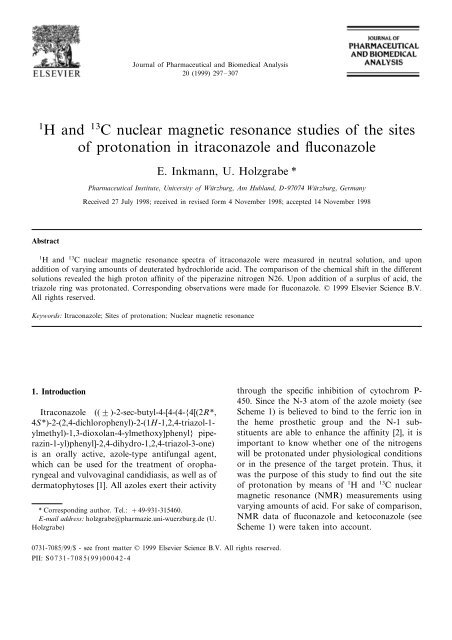

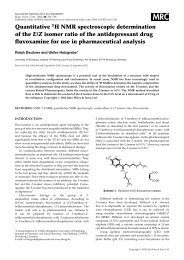
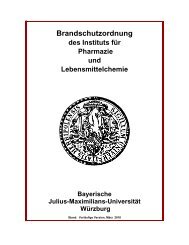
![[2 + 2 + 2]-Cycloaddition of Nitriles with Acetylene - Institut für ...](https://img.yumpu.com/25283701/1/190x245/2-2-2-cycloaddition-of-nitriles-with-acetylene-institut-fur-.jpg?quality=85)



